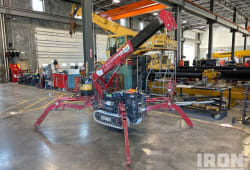About Cranes: Majestic Machines of Modern Engineering
9 Lectura mínima
)
diciembre 22, 2023
Cranes have been an integral part of human civilization for centuries, evolving from simple systems of ropes and pulleys to sophisticated, towering machines that dominate construction sites and industrial landscapes. In this comprehensive exploration, we delve into the world of cranes, examining their history, types, applications, and the crucial role they play in shaping our built environment. From ancient times to modern construction marvels, cranes have been pivotal in shaping skylines and enabling the realization of architectural feats.
Historical Evolution of Cranes
Ancient Origins
The roots of crane technology can be traced back to ancient civilizations, where simple mechanical devices were used for lifting and moving heavy loads. Early cranes were primarily made of wood and operated manually, relying on human or animal power. These ancient origins laid the foundation for the evolution of crane technology, shaping its trajectory through centuries of innovation and development.
101-Everything You Need to Know About Cranes
Medieval Advancements
During the medieval period, cranes saw significant advancements, with the introduction of treadwheel cranes in Europe. These cranes featured a large wheel that could be turned to lift heavy materials, marking a crucial step towards more efficient construction methods. Medieval advancements in crane technology revolutionized construction practices, enhancing the capabilities of builders and contributing to the development of grand structures that defined the era's architectural prowess.
Industrial Revolution
The Industrial Revolution brought about a paradigm shift in crane technology. Steam-powered cranes emerged, revolutionizing construction and manufacturing processes. The ability to harness steam power greatly increased lifting capacities and operational efficiency. This transformative era, known as the Industrial Revolution, marked a pivotal moment in history, reshaping industries and paving the way for unprecedented advancements in technology and production methods.
Types of Cranes
Mobile Cranes
:format(webp))
Hydraulic Cranes: Hydraulic cranes, equipped with advanced hydraulic systems, excel at lifting and transporting heavy loads. Their versatility makes them indispensable in construction projects, where precision and power are paramount. These cranes efficiently leverage hydraulic technology for seamless operations and enhanced performance.
Crawler Cranes: Crawler cranes, equipped with tracks for enhanced mobility, are adept at navigating uneven terrains. Their inherent stability makes them perfect for lifting substantial loads in challenging environments. Crawler cranes are indispensable assets in construction and heavy lifting operations, ensuring efficiency and precision.
Tower Cranes
:format(webp))
Fixed Tower Cranes: Fixed tower cranes, integral in erecting skyscrapers, are anchored to the ground, ascending alongside the building's growth. Their steadfast structure and elevated reach make them indispensable in the construction realm, ensuring precision and efficiency in lifting and placing heavy materials at varying heights.
Self-Erecting Tower Cranes: Self-Erecting Tower Cranes revolutionize construction with their unique capabilities. Transportable as a single unit, they boast the remarkable ability to autonomously erect at the job site. Renowned for their swift setup and exceptional mobility, these cranes redefine efficiency in construction projects.
Overhead Cranes
:format(webp)) Bridge Cranes: Bridge cranes, also known as overhead cranes, are crucial in industries. Mounted on an overhead track, they provide efficient horizontal movement within buildings. Widely utilized in manufacturing and warehousing, these cranes enhance productivity and streamline logistical operations.
Bridge Cranes: Bridge cranes, also known as overhead cranes, are crucial in industries. Mounted on an overhead track, they provide efficient horizontal movement within buildings. Widely utilized in manufacturing and warehousing, these cranes enhance productivity and streamline logistical operations.
Gantry Cranes: Gantry cranes, akin to bridge cranes, operate on tracks with ground-supported legs. This design facilitates movement across extensive spaces, providing versatility in material handling. Gantry cranes are essential in various industries, offering efficient and flexible solutions for lifting and transporting heavy loads.
Specialty Cranes
Telescopic Cranes: Gantry cranes, akin to bridge cranes, operate on tracks with ground-supported legs. This design facilitates movement across extensive spaces. Telescopic cranes, equipped with a telescoping boom, add versatility, as they can extend or retract, adapting to diverse lifting requirements in different industries.
Floating Cranes: Floating cranes, designed to work over water, play a pivotal role in maritime construction projects like bridge building and shipyard activities. These specialized cranes offer unparalleled versatility and are indispensable for efficiently executing complex tasks in aquatic environments.
Modern Applications
Construction Industry
Cranes are indispensable in the construction sector, where they are used for tasks ranging from lifting heavy building materials to placing steel beams. Tower cranes, mobile cranes, and crawler cranes are commonly deployed on construction sites worldwide. The construction industry heavily relies on these versatile machines to enhance efficiency and productivity.
Manufacturing and Warehousing
In manufacturing facilities and warehouses, overhead cranes play a pivotal role in material handling. They enable efficient movement and positioning of heavy components, aiding in the assembly and storage processes. The integration of advanced crane systems enhances productivity and safety, optimizing manufacturing and warehousing operations for increased efficiency and precision.
Shipping and Maritime Operations
Floating cranes play a pivotal role in Shipping and Maritime Operations, vital for efficiently managing the transfer of goods between vessels. These specialized cranes, strategically positioned in ports and shipyards, streamline the intricate process of loading and unloading heavy cargo containers and equipment, ensuring seamless maritime logistics.
Renewable Energy Projects
Cranes are indispensable in advancing Renewable Energy Projects. As the world shifts towards sustainable sources, cranes play a crucial role in installing wind turbines and solar panels. Specialized cranes ensure the precise lifting and positioning of massive turbine components, fostering the growth of clean energy initiatives.
Technological Advancements
Automation and Remote Operation
In recent years, crane technology has undergone remarkable advancements, embracing automation and remote operation capabilities. This integration not only bolsters safety by minimizing human presence in hazardous environments but also elevates overall efficiency. The synergy of innovation and practicality is reshaping the landscape of crane operations, marking a transformative era.
Telematics and Data Analytics
The integration of telematics and data analytics in crane systems revolutionizes performance monitoring. Real-time tracking of metrics facilitates a data-driven approach, empowering predictive maintenance strategies. This innovation minimizes downtime and maximizes operational efficiency, ensuring a seamless and optimized workflow in industrial settings.
Safety Considerations
Operator Training and Certification
Operating cranes demands skilled and certified professionals. Rigorous Operator Training and Certification programs guarantee operators are proficient in safety protocols, equipment functions, and emergency procedures. This ensures optimal performance, mitigates risks, and prioritizes safety in construction sites, emphasizing the critical role of well-trained personnel in crane operations.
Load Monitoring Systems
Load monitoring systems are essential safety features in cranes, preventing overloading and ensuring that the crane operates within its specified capacity. These systems utilize sensors and advanced algorithms to provide accurate load information to the operator. Load monitoring systems play a pivotal role in enhancing operational efficiency and maintaining workplace safety.
Environmental Impact
Energy Efficiency
Recent advancements in crane technology prioritize energy efficiency, mitigating the environmental footprint of operations. Innovative models integrate energy recovery systems like regenerative braking, effectively converting and storing excess energy during lifting tasks. These developments mark a significant stride toward sustainable and eco-friendly crane practices in construction and industrial settings.
Sustainable Practices
The construction industry is evolving with sustainable practices, and cranes are no exception. From using biofuels to incorporating eco-friendly materials in crane construction, the sector aims to minimize its ecological footprint. Sustainable initiatives are reshaping the industry, fostering a commitment to environmental responsibility and long-term resource conservation.
Future Trends and Innovations
Drone Integration
The integration of drones with crane operations is a burgeoning trend. Drones provide aerial views of construction sites, aiding in planning and monitoring. They can also assist in the delivery of materials to hard-to-reach locations. Drone integration optimizes efficiency, enhances safety, and revolutionizes traditional construction practices with innovative aerial capabilities.
3D Printing Technology
Advancements in 3D printing technology present opportunities for revolutionizing crane construction. The integration of 3D printing in crafting crane components promises enhanced efficiency and the development of lightweight, resilient structures. This innovative approach signifies a transformative shift towards more sustainable and adaptable solutions in the realm of heavy machinery.
Cultural and Symbolic Significance
Crane Symbolism
Cranes hold cultural significance in various societies, symbolizing longevity, good fortune, and prosperity. In some cultures, cranes are considered sacred birds and are associated with rituals and ceremonies. Crane symbolism extends beyond the physical realm, embodying grace and elegance. Their majestic presence in folklore and art reflects a universal admiration for these magnificent birds, weaving tales of hope and transcendence into the tapestry of human culture.
Art and Literature
Cranes have inspired artists and writers throughout history. From ancient paintings to modern literature, the majestic and graceful appearance of cranes often serves as a metaphor for beauty, strength, and elegance. Art and literature seamlessly weave these avian symbols into captivating tales and visually stunning works, further immortalizing the crane's significance in human creative expression across diverse cultures and periods.
Conclusion
Cranes, with their towering presence and remarkable capabilities, stand as symbols of human ingenuity and progress. From ancient constructions to modern engineering feats, cranes continue to play a pivotal role in shaping the world we live in. As technology advances, these majestic machines will undoubtedly evolve, contributing to a future where construction and lifting heavy loads are safer, more efficient, and environmentally conscious. Conclusion: The enduring legacy of cranes speaks to our relentless pursuit of advancement. Their evolution mirrors our quest for safer, more efficient, and sustainable solutions. In the grand tapestry of human history, cranes remain integral, bridging the past, present, and future.
Visit Boom & Bucket to buy and sell your machinery.














